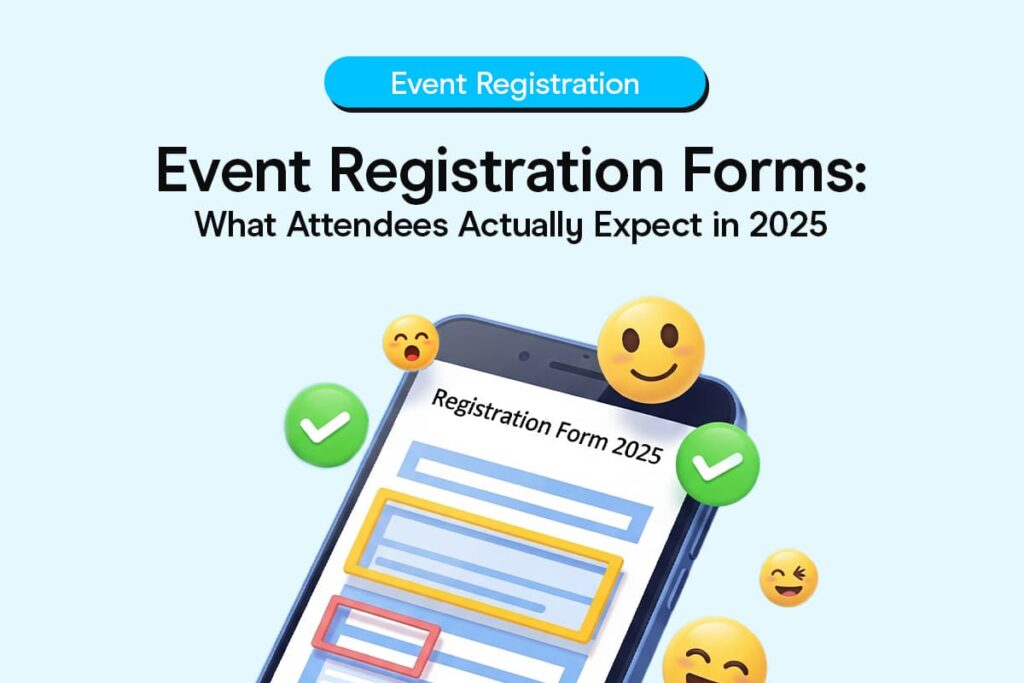I’ve watched thousands of event registrations die in the browser tab graveyard. Not because the event wasn’t compelling, but because the registration form felt like filling out a mortgage application for a networking lunch.
The math is brutal: every additional form field reduces completion rates by roughly 5%. Yet I still see organizers asking for everything from LinkedIn profiles to dietary restrictions before someone can attend a simple webinar. Meanwhile, attendees have been trained by Amazon’s one-click ordering and Netflix’s seamless onboarding. The gap between expectation and reality has never been wider.
The New Baseline: Friction is the Enemy
2025 UX design trends focus on personalization, accessibility, and user-first experiences. Interfaces must feel intuitive, anticipate needs, and remove unnecessary friction. This isn’t just design philosophy—it’s registration reality.
The events that consistently hit their attendance targets have cracked a simple code: they’ve stopped treating registration like data collection and started treating it like user experience. The form isn’t separate from the event; it is part of the event experience.
Smart organizers now think in terms of progressive disclosure. Essential information upfront, nice-to-haves later. Name, email, maybe company if it’s B2B. Everything else can wait until after they’ve committed to showing up.
The Personalization Paradox
Here’s where it gets interesting. Products with hyper-personalisation elements rely on users’ data to adapt to their individual needs. By analysing their behaviour, products can predict their preferences and produce content that is most relevant to them.
But personalization in event registration means asking smarter questions, not more of them. The best forms I’ve seen adapt in real-time based on previous answers. Register for a technical session? The form might surface relevant certifications or experience levels. Choose the in-person option? Location-specific questions appear. Select virtual attendance? Those same questions disappear.
Dynamic questioning feels like magic to users, but it’s really just conditional logic done right. Instead of showing every possible field to every person, you’re creating a conversation that branches naturally based on their choices.
Language Matters More Than You Think
The global event landscape has shifted permanently. Even local events now attract international attendees through hybrid formats. Yet most registration forms are still locked in English-only thinking.
Language preference signals respect. When someone can register in their native language, conversion rates typically jump 20-30%. More importantly, it shows you’ve thought who’s coming to your event, not just what you’re trying to sell them.
The technical implementation matters too. This goes beyond Google Translate widgets bolted onto existing forms. Proper multilingual registration means native language support built into the form logic, with culturally appropriate field formats (date formats, name structures, address conventions).
The Mobile Reality Check
Mobile registrations now account for over 60% of all event sign-ups, yet I still encounter forms that are clearly designed on desktop and grudgingly adapted for mobile. The telltale signs: tiny text, cramped input fields, and that maddening moment when the keyboard covers the submit button.
Accessibility, AI-based automation, and dynamic micro-interactions form the basics of UX forms in 2025. Voice inputs, adaptive layouts for different devices, and gamified experiences would certainly top the enhanced user experience expectations.
Mobile-first design means designing for thumbs, not cursors. Thumb-friendly button sizes, minimal typing, smart auto-complete, and forms that actually work with autofill. The registration should feel as smooth as ordering a rideshare.
Why Platform Choice Determines Success
This is where the rubber meets the road. You can have the best registration strategy in the world, but if your platform can’t execute it, you’re building on quicksand.
The platforms that are winning right now share a few key characteristics: they make customization simple without requiring a computer science degree, they handle the technical complexity of dynamic forms behind the scenes, and they integrate seamlessly with the rest of your event tech stack.
Gevme has built their registration system around these principles. Their platform natively supports dynamic questioning—no custom coding required. Want to show different ticket types based on company size? Built in. Need to collect specific information for workshop tracks? The conditional logic handles it automatically. Multi-language support comes standard, not as an add-on.
More importantly, their approach recognizes that registration data needs to flow seamlessly into the rest of your event ecosystem. Registration systems now connect directly with event apps, creating a seamless experience from sign-up through event completion. Attendee information flows automatically into event apps, eliminating the manual data entry that kills productivity and introduces errors.
The Integration Imperative
The days of standalone registration forms are over. Today’s attendees expect their information to follow them through the entire event journey. Registration data should automatically populate name badges, enable app-based networking, and personalize session recommendations.
This extends far beyond convenience—it creates a cohesive experience that builds trust. When attendees see their preferences reflected throughout the event, from registration through follow-up, it reinforces that you’re paying attention to their individual needs.
The Measurement Gap
Here’s what most organizers get wrong: they measure registration success by completion rates alone. But completion is just the beginning. The real metrics are time to register, drop-off points, support ticket volume, and the correlation between smooth registration and actual event satisfaction.
The best registration forms are invisible. Attendees complete them without thinking about the process, then show up to your event already feeling positive about the experience. That’s the real victory.
Building for What’s Next
The registration trends emerging for 2025 point toward even more intelligent, adaptive experiences. AI-powered form optimization that learns from user behavior. Voice-assisted registration for accessibility. Integration with professional networking platforms for seamless profile building.
But the fundamentals remain the same: respect your attendees’ time, ask for what you need when you need it, and make the process feel like the beginning of something valuable rather than a necessary evil to endure.
Your registration form is your event’s handshake. Make it count.
Stop Losing Registrations to Bad Forms
Build event registration forms that convert with dynamic questions, mobile optimization, and zero friction.
Dynamic event registration forms are intelligent, interactive forms that adapt based on user input. With Gevme, these forms tailor the experience by showing only the relevant questions, helping you improve completion rates and deliver a seamless registration journey.
Traditional forms can overwhelm users with too many questions. Gevme’s dynamic event registration forms use conditional logic to ask only what’s necessary, reducing drop-offs and increasing attendee engagement—especially on mobile devices.
Gevme’s dynamic event registration forms streamline the process by adapting to each registrant’s input. This personalized approach minimizes friction and dramatically boosts form completion and event sign-up rates.
Yes. Gevme’s dynamic event registration forms integrate effortlessly with CRMs, event apps, email systems, and other tools, ensuring your attendee data flows seamlessly throughout your entire event ecosystem.
Definitely. Gevme designs all dynamic event registration forms with a mobile-first approach—thumb-friendly buttons, smart auto-complete, and layouts that adapt perfectly to any device for a smooth, frustration-free registration experience.


